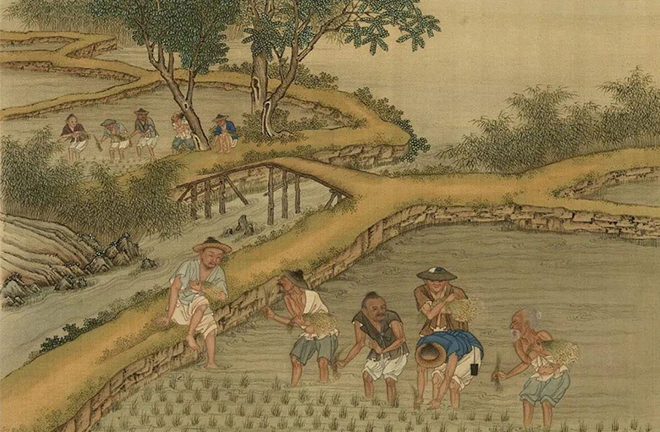Get busy planting with the arrival of Grain in Ear

FILE PHOTO: A detail of “Farming and Weaving” by the Qing artist Chen Mei
“Grain in Ear,” also known as “Mang Zhong” in Chinese, is one of the 24 Solar Terms, typically occurring around June 5th to 7th. The ancient Chinese divided the sun’s annual circular motion into 24 segments, each known by a specific “Solar Term.” The criteria for the formulation of the 24 solar terms were developed through the observation of seasonal changes, astronomy, and other natural phenomena in the Yellow River basin and were progressively adopted nationwide. The solar terms have been passed down through generations and are used traditionally as a timeframe to direct agricultural production and daily routines.
Busy season for farmers
In 2024, Grain in Ear commenced on June 5. This term first appeared in the Rites of Zhou, an ancient classic likely compiled during the Western Zhou Dynasty. Zheng Xuan of the Eastern Han Dynasty explained it as: “Wherever marsh grass grows, that land can be used to plant awny crops [“mang” means awny]. Those awny crops refer to rice and wheat.” A more accurate interpretation, aligning better with the modern understanding of Grain in Ear, is given by Ma Yongqing of the Song Dynasty: “The so-called Grain in Ear of the fifth lunar month represents the peak time for wheat harvest and also a deadline for rice planting tasks.”
The term “Grain in Ear” marks the time of year when temperatures increase significantly and rainfall is plentiful. During this time, farmers across China are busy with the summer harvest in the north and summer planting in the south. Consequently, this solar term is also commonly referred to as “Busy Planting” [a homonym of Grain in Ear in Chinese].
The ancients observed three significant natural phenomena that usually occur during Grain in Ear. As temperatures rise and rainfall increases, mantis eggs laid in the previous autumn begin to hatch and young mantises appear. Shrikes start to sing, while mockingbirds cease their chirping.
Cultural practices
In the rhythmic breath of nature, people continually perceive and document the flow of time, expressing their reverence for nature through various customs and celebrations. In southern Anhui, a ritual known as “An Miao” [meaning seedling protection] has been practiced during the Grain in Ear period since the Ming Dynasty. After sowing the rice, locals prepare steamed buns using freshly-harvested wheat flour, shaping them into various forms and coloring them with vegetable juice. These buns serve as offerings to pray for a bountiful harvest and the safety of the people.
With the arrival of Grain in Ear, regions in the middle and lower reaches of the Yangtze River are poised to enter the Plum Rains season. This period of persistent rainy weather occurs in late spring and early summer in East Asia, coinciding with the ripening of plums. The overlap of these events naturally connects the rainy season with the plum harvest, making it a perfect time to produce and consume plum wine. The process of making plum wine involves soaking fresh plums in alcohol and sugar, allowing the flavors to infuse over time. The rainy season also provides the ideal environmental conditions for starting this process. Legend recounts a celebrated encounter between Cao Cao and Liu Bei, two rival leaders in the Three Kingdoms period (220–280), who discussed heroism and contemporary politics over hot wine and green plums.
Eating chard during the Grain in Ear period is a common custom of the people of Ningbo, in southern China. This practice is rooted in local beliefs and traditions. It is said that eating chard during this time can help keep the skin smooth and prevent heat-related ailments like rashes, which are common in the early summer.
In ancient China, the Grain in Ear solar term marked the seasonal transition that signaled the end of the blooming season, giving rise to the tradition of bidding farewell to the deities or spirits of flowers. Although this custom has largely disappeared from modern China today, its lively spirit and the excitement of the ceremony can still be experienced through literature. In the 27th chapter of the 18th-century novel A Dream of Red Mansion, this tradition is vividly described: “The next day was the twenty-sixth of the fourth month, the Festival of Grain in Ear. It was the time-honored custom on this day to offer all manner of gifts and a farewell feast to the God of Flowers, for this festival was said to mark the beginning of summer when all the blossoms had withered and the God of Flowers had to resign his throne and be seen off. As this custom is most faithfully observed by women, all the inmates of Grand View Garden rose early that day. The girls used flowers and osiers to weave small sedan-chairs and horses, or made pennants and flags of silk and gauze which they tied with gay ribbons to every tree and flower, turning the whole garden into a blaze of color. They decked themselves out so prettily, too, as to put the very flowers and birds to shame. But time forbids us to dwell on that splendid scene” (trans. Yang Xianyi and Gladys Yang).
Edited by REN GUANHONG
